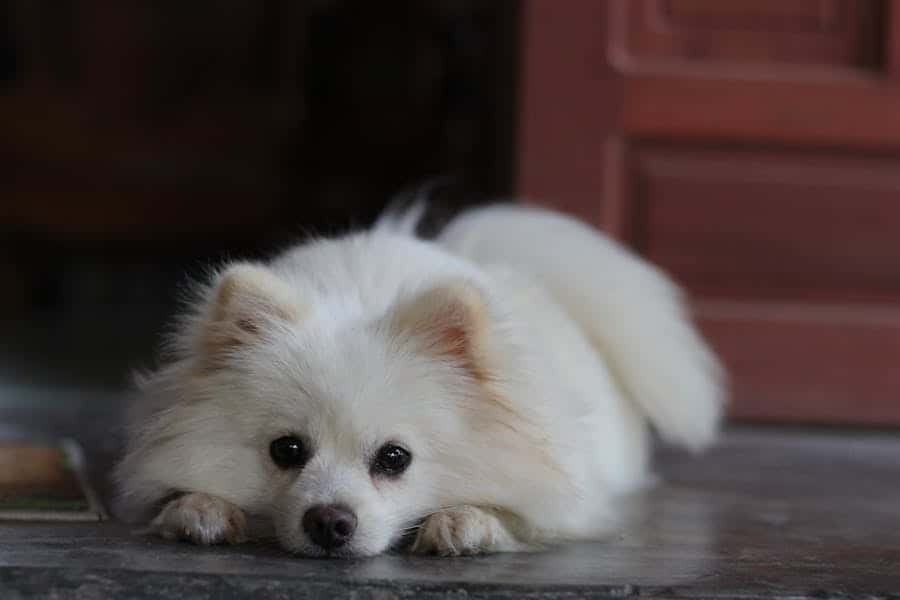Pomskies can grow to a size of 20-30 lbs. These adorable hybrid dogs reach their full-grown size within a year, with significant growth happening within the first six months.
Pomskies, a crossbreed between Pomeranian and Siberian Husky, are known for their small to medium size. Their weight typically ranges from 20 to 30 pounds. As a designer breed, Pomskies are highly sought after for their adorable appearance and playful nature.
However, their size can vary depending on the individual dog and the genetics inherited from their parents. While Pomskies can grow to be smaller or larger than the average range, they generally reach their full-grown size within a year. The first six months of their growth are especially crucial, as they experience significant development during this time. When considering a Pomsky, it’s essential to be prepared for their potential size and provide them with the appropriate care and attention they need.
Unveiling The Pomsky Growth Secrets
The Genetics Behind Pomsky Growth
Understanding the growth patterns of Pomskies can be attributed to the genetics inherited from their parent breeds, the Siberian Husky, and the Pomeranian. The genetic makeup of these breeds plays a crucial role in determining the potential size and physical characteristics of Pomskies. It is essential to acknowledge the influence of genetics when exploring the growth trajectory of these adorable hybrids.
Factors Affecting Pomsky Size
Several factors contribute to the size of Pomskies, including genetics, diet, exercise, and overall health. By addressing these key factors, Pomsky owners can better understand and manage the growth of their beloved pets. Factors such as nutrition and exercise directly impact the growth and development of Pomskies, making it imperative for owners to prioritize a healthy lifestyle to support their pet’s optimal growth.

Credit: luckytail.com
Understanding The Adult Pomsky Appearance
If you are considering getting a Pomsky, it is important to understand how they mature and what their adult appearance will be like. Pomskies are a cross between a Pomeranian and a Siberian Husky, resulting in a unique and adorable mix. In this section, we will explore the characteristics of an adult Pomsky and the factors that influence their physical appearance.
Characteristics Of An Adult Pomsky
When it comes to the appearance of an adult Pomsky, there are several key characteristics to consider:
- Size: Pomskies can vary in size, depending on the parental breeds and genetics. On average, adult Pomskies typically weigh between 20-30 pounds, but they can range anywhere from 15 to 35 pounds.
- Coat: Pomskies often have a thick double coat, inheriting the beautiful fur of both Pomeranians and Huskies. Their coat can come in a variety of colors, including black, white, gray, and tan.
- Eye Color: The eye color of a Pomsky is another unique aspect of their appearance. They can have blue eyes, brown eyes, or even one of each, offering a mesmerizing and captivating look.
- Facial Features: Pomskies typically have a fox-like face with a cute button nose, reminiscent of their Pomeranian heritage. Their ears can be erect or semi-erect, giving them an alert and expressive expression.
Factors Influencing Physical Appearance
The physical appearance of an adult Pomsky is influenced by several factors:
- Genetics: The genetics of the parental breeds play a significant role in determining the size, coat color, and other physical traits of a Pomsky. Each puppy in a litter can vary in appearance, even if they have the same parents.
- Nutrition: Providing a healthy and balanced diet is crucial for the overall development and physical appearance of a Pomsky. Good nutrition ensures proper growth and maintains a shiny coat.
- Exercise: Regular exercise helps to keep a Pomsky in shape and prevent obesity. Physical activity also contributes to their muscle development and overall well-being.
- Grooming: Pomskies have a moderate shedding tendency and require regular grooming to maintain a healthy coat. Brushing their fur, trimming their nails, and cleaning their ears are essential grooming routines.
- Healthcare: Regular veterinary care, including vaccinations and preventive treatments, is vital to keep a Pomsky healthy. Issues like dental care, parasite prevention, and addressing any underlying health concerns can also impact their appearance.
By understanding the characteristics of an adult Pomsky and the factors that influence their physical appearance, you can have a better idea of what to expect. Remember, each Pomsky is unique and will have its own individual traits and personality. If you are considering adding a Pomsky to your family, make sure to provide the love, care, and attention they need to thrive.
Decoding Pomsky Growth Stages
Understanding the growth stages of Pomskies is essential for their proper care and development. Each stage – Puppy, Adolescent, and Adult – brings its unique characteristics and requirements.
Puppy Stage
In the Puppy Stage, Pomskies are at their most adorable and vulnerable. This stage typically lasts from birth to around 1 year old, during which they experience rapid growth and development.
Adolescent Stage
Transitioning into the Adolescent Stage marks a period of adjustment for Pomskies. Typically occurring between 1 to 2 years old, this stage is characterized by increased independence and testing boundaries.
Adult Stage
As Pomskies reach the Adult Stage, usually around 2 years old and older, they have fully matured physically and behaviorally. This stage signifies the stability and consistency in their size and temperament.
How Big Can A Pomsky Get?
Curious about how big a Pomsky can get? Pomskies, a mix between a Pomeranian and a Siberian Husky, inherit their size from their parents, resulting in a range of sizes. Understanding the factors that impact the final size of a Pomsky can help provide insight into their full-grown proportions. Let’s delve into the details of ‘How Big Can A Pomsky Get?’ and explore the factors impacting their final size.
Average Full-Grown Weight
On average, a full-grown Pomsky can weigh between 20-30 pounds. However, the final weight of a Pomsky can vary greatly, with some Pomskies weighing as little as 15 pounds and others reaching up to 40 pounds. The weight of a Pomsky is influenced by several factors, making it essential to consider various elements when estimating the potential size of a Pomsky.
Factors Impacting Final Size
The final size of a Pomsky is influenced by genetic factors inherited from their Pomeranian and Siberian Husky parents. Additionally, diet, exercise, and overall health play a crucial role in determining a Pomsky’s size. Furthermore, the specific lineage of a Pomsky can impact their ultimate size, as well as individual variations within the breed.
The Dynamics Of Pomsky Personality
A Pomsky, a cross between a Pomeranian and a Siberian Husky, is an adorable and popular designer breed. Not only are they known for their striking appearance, but they also have a unique and interesting personality. Understanding the dynamics of a Pomsky’s personality is essential for any potential owner, as it allows them to better connect and train their furry friend to ensure a harmonious relationship.
Temperament & Behavioral Traits
The temperament of a Pomsky can vary depending on the characteristics they inherit from both parent breeds. Pomeranians are often lively and outgoing, while Huskies are known for their intelligence and independent nature. As a result, Pomskies tend to be a delightful blend of both traits.
- Pomskies are intelligent and curious, making them quick to grasp new commands and learn new tricks.
- They are known for their loyalty, often forming strong bonds with their owners and family members.
- While Pomskies are generally friendly and sociable, they can be cautious around strangers and may exhibit some level of aloofness.
- Some Pomskies may have a tendency to be vocal, which can be attributed to their Pomeranian heritage. However, with proper training and socialization, this behavior can be managed effectively.
- Due to their high energy levels, Pomskies require regular exercise and mental stimulation to prevent boredom and destructive behavior.
Effect Of Training On Behavior
Training plays a crucial role in shaping a Pomsky’s behavior and overall temperament. With consistent and positive reinforcement training methods, owners can help their Pomskies become well-mannered and well-adjusted companions.
| Training Tips for Pomskies: |
|---|
| 1. Start training early: Begin training your Pomsky as soon as you bring them home. Early socialization and obedience training will set a solid foundation for their behavior. |
| 2. Use positive reinforcement: Reward-based training methods, such as treats, praise, and play, can motivate Pomskies and encourage them to repeat desired behaviors. |
| 3. Be consistent: Consistency in training is key to ensuring that your Pomsky understands what is expected of them. Establish clear rules and expectations and reinforce them consistently. |
| 4. Provide mental stimulation: Keep your Pomsky engaged and mentally stimulated through interactive toys, puzzle games, and training exercises. This helps prevent boredom and destructive behavior. |
| 5. Practice patience and persistence: Training takes time and patience. Be prepared to repeat commands and reinforce positive behaviors until they become second nature to your Pomsky. |
With a well-rounded training approach, Pomskies can develop into well-behaved, happy, and confident dogs.
Addressing Common Pomsky Growth Concerns
When bringing a Pomsky into your life, it’s common to have concerns about their growth. How big will they grow? Are there specific health issues and care requirements to be aware of? This article aims to address these common Pomsky growth concerns, shedding light on factors such as shedding, health issues, and care.
Shedding
Pomskies are known for their beautiful coat, but they also have a reputation for shedding. Understanding the shedding patterns of Pomskies can help you manage this aspect of their care. Regular grooming can minimize shedding and keep their coat healthy. Due to their double coat, brushing twice a week can help in maintaining their fur and reduce shedding.
Health Issues & Care
Ensuring the overall well-being of Pomskies involves knowing about potential health issues and providing the necessary care. Regular check-ups with a veterinarian are essential to monitor their health and address any concerns promptly. It’s also important to maintain a balanced diet and provide sufficient exercise to keep them healthy and fit.
Frequently Asked Questions For How Big Do Pomskies Grow
How Big Is A Full Size Pomsky?
A full-size Pomsky typically weighs between 20-30 lbs when fully grown, varying based on genetics.
Are Pomsky Good Dogs?
Pomskies are good dogs known for their loyalty. They may bond closely with one person but generally get along well with others. They might be wary around young children, so families should assess compatibility based on their dynamics.
At What Age Do Pomskies Stop Growing?
Pomskies typically stop growing at around one year old. They can reach their full grown size within this time frame.
Are Pomskies Yappy Dogs?
Pomskies can be yappy, like Pomeranians, or talkative, like Huskies. Proper training from an early age helps maintain a balanced temperament.
How Big Do Pomskies Grow?
Pomskies can vary in size, typically ranging from small to medium sizes when fully grown.
Conclusion
Pomskies can vary in size as they grow, but on average, a full-grown Pomsky weighs between 20-30 pounds. It is important to note that the size of a Pomsky can also depend on the genes they inherit. By around six months, they are more than halfway done growing, and within a year, they usually reach their full-grown size.
So, if you are considering adopting a Pomsky, be prepared for their size to vary and enjoy watching them grow into their unique stature.

